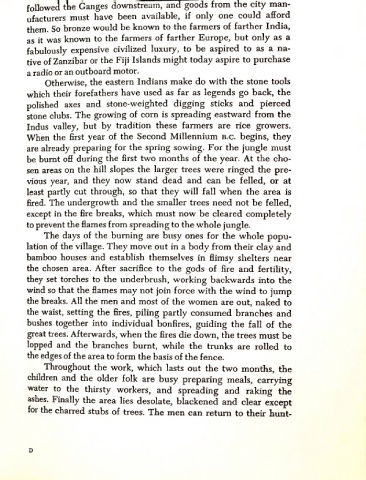Page 58 - Four Thousand Years Ago by Geoffrey Bibby
P. 58
followed tne Ganges downstream, and goods from the city man
ufacturers must have been available, if only one could afford
them. So bronze would be known to the farmers of farther India,
as it was known to the farmers of farther Europe, but only as a
fabulously expensive civilized luxury, to be aspired to as a na
tive of Zanzibar or the Fiji Islands might today aspire to purchase
a radio or an outboard motor.
Otherwise, the eastern Indians make do with the stone tools
which their forefathers have used as far as legends go back, the
polished axes and stone-weighted digging sticks and pierced
stone clubs. The growing of corn is spreading eastward from the
Indus valley, but by tradition these farmers are rice growers.
When the first year of the Second Millennium b.c. begins, they
are already preparing for the spring sowing. For the jungle must
be burnt off during the first two months of the year. At the cho
sen areas on the hill slopes the larger trees were ringed the pre
vious year, and they now stand dead and can be felled, or at
least partly cut through, so that they will fall when the area is
fired. The undergrowth and the smaller trees need not be felled,
except in the fire breaks, which must now be cleared completely
to prevent the flames from spreading to the whole jungle.
The days of the burning are busy ones for the whole popu
lation of the village. They move out in a body from their clay and
bamboo houses and establish themselves in flimsy shelters near
the chosen area. After sacrifice to the gods of fire and fertility,
they set torches to the underbrush, working backwards into the
wind so that the flames may not join force with the wind to jump
the breaks. All the men and most of the women are out, naked to
the waist, setting the fires, piling partly consumed branches and
bushes together into individual bonfires, guiding the fall of the
great trees. Afterwards, when the fires die down, the trees must be
lopped and the branches burnt, while the trunks are rolled to
the edges of the area to form the basis of the fence.
Throughout the work, which lasts out the two months, the
children and the older folk are busy preparing meals, carrying
water to the thirsty workers, and spreading and raking the
ashes. Finally the area lies desolate, blackened and clear except
for the charred stubs of trees. The men can return to their hunt

